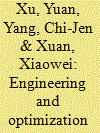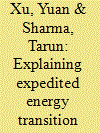| Srl | Item |
| 1 |
ID:
124304


|
|
|
|
|
| Publication |
2013.
|
| Summary/Abstract |
China has made improving the thermal efficiencies of its coal-fired power plants a national priority. Official data show that the average thermal efficiency was enhanced from 31.3% in 2000 to 33.2% in 2005 and 36.9% in 2010. This paper aims to assess the validity of China's claimed improvement, examine major responsible factors, and identify future improvement opportunities. Recognizable factors can account for about 80% of the reported progress in the 10th Five-Year Plan (2001-2005) and about 85% in the 11th (2006-2010) to largely verify the reported progress. Engineering approaches-especially replacing inefficient power units with more efficient ones-are the largest contributing factors, while optimization approaches-particularly electricity dispatch-remains inefficient in China. In 2010, the explainable efficiency improvement might have avoided around 500 million tons of CO2 emissions. In comparison, although the United States was fairly static with most of its coal-fired power plants seriously outdated, it has more efficient electricity dispatch. In China's ongoing 12th Five-Year Plan (2011-2015), better dispatch patterns could be more important as opportunities for improvement through engineering approaches have been largely exhausted.
|
|
|
|
|
|
|
|
|
|
|
|
|
|
|
|
| 2 |
ID:
185720


|
|
|
|
|
| Summary/Abstract |
Energy transition toward renewables, mainly wind and solar, has gained momentum in the past decade. Although the COVID-19 pandemic brought unprecedented, multi-faceted challenges and uncertainties, India witnessed an expedited energy transition in 2020. With our newly constructed Electric System Dispatch Model for India (ESDMI), this study aims to provide an explanation of the underlining mechanisms. The Janta Curfew (7am-9pm) in India was observed on March 22, 2020 followed by a 21-day complete lockdown starting March 25, 2020 to control the spread of the virus. Electricity demand in India dropped by nearly a quarter. We model the supply-side dynamics prior to and during the pandemic response as well as in a counterfactual scenario in the pandemic's absence. We find that the expedited energy transition could be explained by (i) the higher priority of a large renewables fleet to access electric grid either through stipulations and the merit order effect, and (ii) coal-fired electricity generation is less flexible than natural gas and hydropower units. A substantial amount of coal-fired power plants in India are still far from reaching their designed lifetimes. Their low resilience in such crises could exacerbate the problem of stranded assets.
|
|
|
|
|
|
|
|
|
|
|
|
|
|
|
|